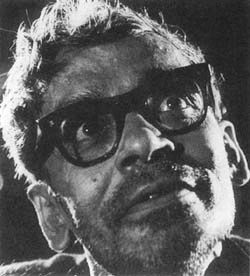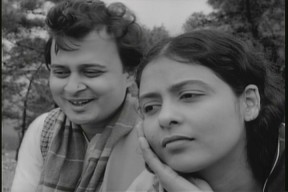In an age when film makers masquarade as reformers, it is only apt that one remember the flag bearers of the REAL New Wave in Indian Cinema that had its inception in the early 50’s through the mid 70’s. A beacon of this New Wave was Ritwik Ghatak. The Anarchist. The Rebel. The quintessential Bengali Intellectual. The man who influenced a generation of film makers.
In a foreword to Ghatak’s seminal work Cinema and I, Rows and Rows of Fences: Ritwik Ghatak on Cinema, none less than Satyajit Ray said about him: “For him Hollywood might not have existed at all.”
Ghatak and his family formed part of the massive exodus from East Pakistan (now Bangladesh) to Kolkata owing to the Partition – the tragedy that haunted him all his life and kept coming back as a recurring theme in his films. Heavily influenced by Sergei Eisenstein and Bertolt Brecht, he had always intended his cinema to be harbinger of social change.
His creative genius was not restricted to cinema alone. He was an active participant of IPTA. He was the first to have translated Gogol and Brecht to Bengali. He was a stage/screen actor of immense calibre.
Two common strands to be noticed through his films are:
1. The Tragedy of Partition – the subcontinent equivalent to holocaust, in terms of magnitude.
2. Tragic undertones to the stories that he had to tell.
With the possible exception of Komal Gandhar/E – Flat (1961) and Bari Theke Paliye/The Runaway (1959), all of his films ended on a tragic note. But by no means can we call them morbid. His cinema was about celebration of life in all its manifestations – hope, despair, fun, laughter and tears coexisted and yet helped shape a coherent, lucid flow of narration. Sounds uncannily similar to Bollywood melodrama? Far from it. Or maybe that contradiction in irony was his forte.
He was bent on wedding his political activism with cultural content by fashioning popular forms of melodrama into appropriate vehicles for political expression. As Megan Carrigy puts it, “Ghatak declared on a number of occasions that if some other medium came along enabling him to reach more of the masses, he would happily drop cinema and embrace that other medium”….
Filmography
Ghatak’s career consisted of but eight feature-length films. But each one of them is equally remarkable. I don’t know of any film maker in Indian or world cinema who could achieve that. Even Satyajit Ray faltered, for crying out loud!
He started off as an actor with Nemai Ghosh’s Chinnamul (1950), of which he was also the assistant director.
Some of the gems directed by him were:
Nagarik/ The Citizen (1952)
The film is an extraordinary parable of a migrant/refugee family in Kolkata, victim of Partition and their longing for the life of grandeur/ prosperity that was once theirs, and how they end up in a slum and discard all hopes of deliverance. About Nagarik, Ray said once that had Nagarik been released before his Pather Panchali, the former would have been accepted as the first film of the alternative form of Bengali cinema.
Ajantrik/ The Pathetic Fallacy (1958)
One of my favorites. Bimal (Kali Bannerjee) is in love with his car, a much torn-and-tattered Chevrolet which he plies as a taxi and calls it Jagaddal affectionately. He talks to it, pampers and cares for it almost as if it were his Lady Love. Modernisation plays foul – his car breaks down and is sold for scrap (criminal simplification; but couldn’t help it).
Meghe Dhaka Tara/ The Cloud-capped Star (1960)
Another of my favorites. One of the best performances in the history of Bengali, and indeed, Indian cinema by Supriya Choudhury who plays Neeta, the only bread-earner of a family consisting of her parents and two brothers. She ends up in a sanatorium for tuberculosis. She sacrifices no end for her family, but loses everything she held dear in the process. Oh, who can forget her anguish-filled cry: “Ami je bachte cheyechilam, Dada!” (“But I wanted to LIVE, brother!”)
There are five more (Bari Theke Paliye/ The Runaway -1959, Komal Gandhar/ E- Flat -1961, Titas Ekti Nadir Naam/ A River Named Titas -1973, Subarnarekha/ The Golden Line -1962, and Jukti Tokko Aar Goppo/ Reason, Debate and A Story -1974)…one can keep going for miles and miles, writing about these refreshing masterpieces.
Such was the man. Maverick. Eccentric. One crazy film maker who had his head (or heart?) in the right place.
Oh, I forgot to mention, he taught at FTII, too, and his legacy lived on through the works of his illustrious students – Mani kaul, Kumar Sahani, Ketan Mehta and John Abraham (The torch-bearer of Malayalam New Wave in cinema, that’s who)
Let me wind up by quoting Jacob Levich:
“Satyajit Ray is the suitable boy of Indian film, presentable, career-oriented, and reliably tasteful. Ghatak, by contrast, is an undesirable guest: he lacks respect, has “views”, makes a mess, disdains decorum.”
That was Ritwik Ghatak.
Amborish Roychoudhury is a film enthusiast and a film buff who lives within this outer shell of a finance professional. He is extremely passionate about films, comics, old Hindi film music, detective fiction, technology and the like – He worships many deities but works for the devil! Another Blog that he write occasionally is http://amborish.posterous.com/ or just go to amborish.com







